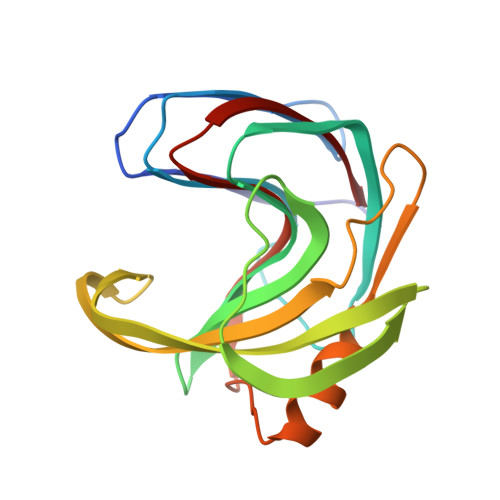Thermal Stabilization of Bacillus subtilis Family-11 Xylanase by Directed Evolution
Miyazaki, K., Takenouchi, M., Kondo, H., Noro, N., Suzuki, M., Tsuda, S.(2006) J Biol Chem 281: 10236-10242
- PubMed: 16467302
- DOI: https://doi.org/10.1074/jbc.M511948200
- Primary Citation of Related Structures:
2DCY, 2DCZ - PubMed Abstract:
We used directed evolution to enhance the thermostability of glycosyl hydrolase family-11 xylanase from Bacillus subtilis. By combining random point mutagenesis, saturation mutagenesis, and DNA shuffling, a thermostable variant, Xyl(st), was identified which contained three amino acid substitutions: Q7H, N8F, and S179C. The half-inactivation temperature (the midpoint of the melting curves) for the Xyl(st) variant compared with the wild-type enzyme after incubation for 10 min was elevated from 58 to 68 degrees C. At 60 degrees C the wild-type enzyme was inactivated within 5 min, but Xyl(st) retained full activity for at least 2 h. The stabilization was accompanied by evidence of thermophilicity; that is, an increase in the optimal reaction temperature from 55 to 65 degrees C and lower activity at low temperatures and higher activity at higher temperatures relative to wild type. To elucidate the mechanism of thermal stabilization, three-dimensional structures were determined for the wild-type and Xyl(st) enzymes. A cavity was identified around Gln-7/Asn-8 in wild type that was filled with bulky, hydrophobic residues in Xyl(st). This site was not identified by previous approaches, but directed evolution identified the region as a weak point. Formation of an intermolecular disulfide bridge via Cys-179 was observed between monomers in Xyl(st). However, the stability was essentially the same in the presence and absence of a reducing agent, indicating that the increased hydrophobicity around the Cys-179 accounted for the stability.
Organizational Affiliation:
Institute for Biological Resources and Functions, National Institute of Advanced Industrial Science and Technology (AIST), Central 6, 1-1-1 Higashi, Tsukuba, Ibaraki 305-8566, Japan. miyazaki-kentaro@aist.go.jp

















